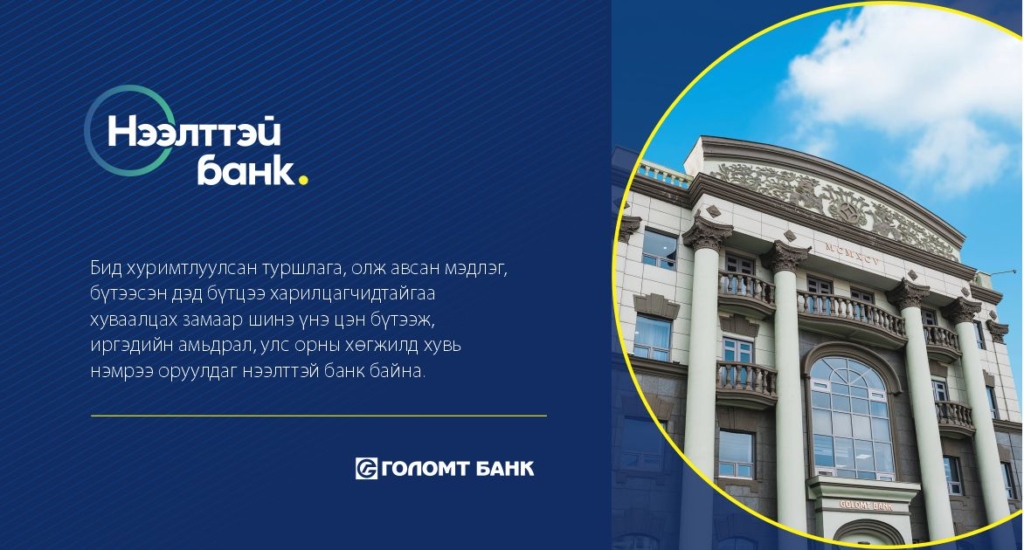
Good afternoon. You have worked for banks around the world, such as in Japan, USA, Netherland, Middle East, and Cambodia. You have also been managing leading banks of Mongolia for the last 10 years. What are the main distinctive characters of Mongolian banking industry compared to other countries?
Mongolia’s banking sector is successful in providing banking services to most of the population, despite of the country’s large land with people scarcely located. It is a great achievement. There are many people around the world who live without access to banking services. Rapid development of use of digital technology in banking services is another characteristic of Mongolia’s banking sector. The banking sector is playing a crucial role in Mongolian economy and leading digital transformation as well.
I also would like to mention that the banks are in competitive environment under the market mechanism and constantly and continuously competing to provide customers with better services.
What are the upcoming main challenges and chances in Mongolian economy? The last two years were not good for economy around the world. How do you see the future of Mongolian economy?
Mongolia still has a good potential of economic growth. COVID-19 pandemic made our economic activities different and challenging. Latest global geopolitical events have been changing economic and business environment significantly, too. However, once the border closure is lifted within this year, then Mongolian economy’s robust recovery may take place. The country needs recovery of foreign investment. Policy makers and regulators need to establish stable legal environment and execute laws and regulations in a consistent and transparent manner so that foreign investors would feel comfortable to invest in Mongolia.
When you took the CEO position at Golomt bank, what were your prime objectives?
I took the CEO position of Golomt bank in 2019. My prime objectives were to enhance the bank’s governance and risk management, and to build up strong financial base of the bank. In this way, Golomt bank would be able to further contribute to the development of Mongolia’s economy and society in a sustainable way. Cooperating more with international development institutions is another important objective that will allow us to support our customers more effectively. The bank is committed to have good governance and transparency.
Since 2018, we have taken No.2 position in the banking system in terms of operating profit
What are the biggest achievements of Golomt bank in recent years?
The bank has made two big achievements in the last four years. One is that the bank’s day to day operations and business activities made progress and the bank has maintained strong annual operating profit (before provisioning) even under the pandemic. The bank has been successful in diversifying its business portfolio well among Corporate, SME and Retal segments and since 2018, we have taken No.2 position in the banking system in terms of operating profit. This indicates the bank has established strong profit generation base with well-balanced business segment portfolio. Now the bank is completing the problem assets disposal and credit expense has started decreasing. With strong operating profit generation and completion of past problem assets disposal together we expect our net profit will recover significantly.
Banking industry is greatly affected by technological changes. How it looks like in next 10 years?
Digital technology will continue to change the banking and financial industry further. In ten-year time, we will have new products and services, with digital, AI, and blockchain technology, that we could not think of before. Digital technology is a good fit to financial industry. Golomt bank intends to provide customers with ubiquitous and one-stop services by collaborating with fintech companies, NBFIs and securities firms. Mongolia’s capital market is rapidly growing lately. Technology will support growth of the capital market further, too. Mongolia’s financial sector is expected to utilize the new technologies well to provide customers with safe, quick and efficient services.
IPO will increase the transparency of the banking sector.
The amendments to the Banking Law require systemically large five banks to become public companies through IPOs in the stock market. How will this change affect this sector and Golomt bank?
IPO of the banks will have a significant importance for the banks and for the development of Mongolia’s stock market. Through IPO, the banks will be able to raise capital from public investors and will be more responsible to have good governance, appropriate disclosure and be accountable to all shareholders and stakeholders. IPO will increase the transparency of the banking sector. The public investors will become the bank’s owner and share the benefit of growth of the bank. Raising capital from public investors is a great step for the bank’s long-term growth. The banks utilize the raised capital to provide customers with more and better services and to contribute to the sustainable development of the economy.
Golomt bank describes itself as Open bank. What is Open bank?
Golomt bank takes “Open banking” strategy. “Open banking” refers to several openness of the bank. Firstly, we are open to work and actively collaborate with other financial service sectors; fintech companies, NBFIs, and securities firms, including using our digital platforms. Secondly, we are open to our customers to improve our services. We listen to customers’ voices carefully and make our services more convenient, easy to use efficient and customer friendly. We also actively interact with SME customers to share and exchange the knowledges for the best of the customer’s business expansion. Thirdly, we will be more open to the public especially through IPO. We will communicate with the public and the market more openly in a transparent and responsible manner. Under the “Open banking” strategy, we keep our doors wide open to trusted partner and valued customers.

Golomt bank is very keen to lead, to contribute and to support such sustainable development initiatives.
We know that promoting sustainable development is one of the main agenda of Golomt bank. How is the sustainable development policy reflected in the banking sector?
Achieving the Sustainable Development Goals (SDGs) is a critical global agenda that human being must act on to fight against global warming and keep our environment and society sustainable to pass on to future generations. Many countries and big businesses have committed to achieve Net-zero of carbon emissions by 2050. Mongolia has Nationally Determined Contribution (NDC) targets to have 30 percent of the total energy be renewable by 2030 and to reduce greenhouse gas (GHG) by 22.7% from the projected level of 2030. Mongolia’s banking sector was one of the first in officially addressing the sustainable development in 2013. Golomt bank is very keen to lead, to contribute and to support the sustainable development initiatives.
Within scope of sustainability policy of Golomt bank, what are the main priorities?
First, the bank aims to increase sustainable and green finance. The bank supports green projects and customers’ green efforts by financing. To work for green projects, it is necessary to acquire basic knowledge of environmental science and mechanism of greenhouse gas reduction. Now the bankers need to have more scientific knowledge to support customers to effectively reduce greenhouse gas emissions, use renewable energy and improve waste management, etc.
Second, the bank conducts appropriate environmental and social risk management. The bank’s loans should not be used for environmentally or socially harmful businesses and projects. The bank must avoid supporting businesses and projects that have negative impact on the environment and society. Even though the bank may miss some short-term commercial profit opportunity, we refrain from supporting such negative businesses and projects.
Third, the bank improves our own footprint on its operation’s environmental and social impact. The bank continuously makes efforts such as to save energy, use renewable energies, and manage the waste in our daily business operations. Making our facilities and services accessible and easier to use for people with disabilities, for example, is also a target.
Forth, we must build capacity of our staff to promote sustainable finance effectively. The bank staff need to be more knowledgeable about environmental and social issues. The bank provide the staff with training and opportunities to exchange knowledge and experiences with other financial institutions, public organizations and civil societies.
The last but not the least, the bank makes reporting to fulfill accountability of our sustainable finance initiatives. We should not fall in “green washing (just talking and pretending green without actions)”. We must report how much we are doing for sustainability. We publicly report what we have done and what we have not done yet.
These are core pillars of sustainable finance that the bank pursues.
Thank you for interviewing.